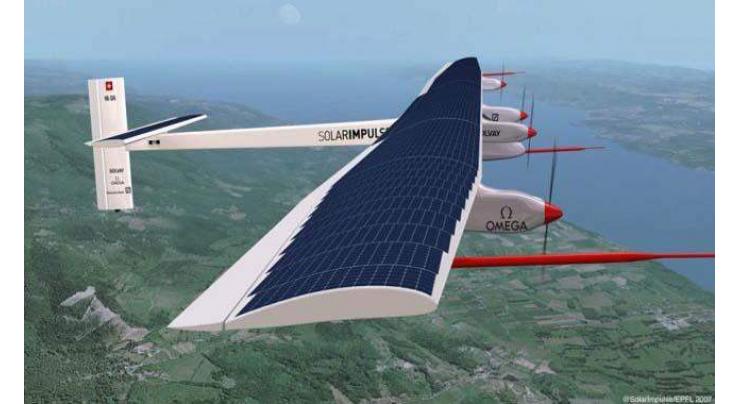
Solar Plane Nears End Of Historic Round-the-world Trip
Rukhshan Mir (@rukhshanmir) Published July 25, 2016 | 03:41 PM

ABU DHABI, (APP - UrduPoint / Pakistan Point News - 25th july,2016) - Solar Impulse 2 was on Monday approaching the end of its epic bid to become the first sun-powered airplane to circle the globe without a drop of fuel to promote renewable energy. When the experimental aircraft touches down in Abu Dhabi in the early hours of Tuesday it will cap a remarkable 42,000-kilometre (26,097 mile) journey across four continents, two oceans and three seas. With Swiss explorer and project director Bertrand Piccard in the cockpit, the plane is due to land at Al-Bateen Executive Airport in the UAE capital where it launched its tour on March 9, 2015. On Monday Solar Impulse 2 was flying over the Saudi desert north of Riyadh, heading towards the Gulf. "After a turbulent night from extreme high temperatures, the sun rose above a desert of sand dunes above #SaudiArabia," Piccard said on Twitter. Dubbed the "paper plane", Solar Impulse 2 is circumnavigating the globe in stages, with 58-year-old Piccard and his compatriot Andre Borschberg taking turns at the controls of the single-seat aircraft. It took off from Cairo on its final leg early on Sunday, having previously crossed Asia, North America, Europe, and North Africa. Borschberg, 63, smashed the record for the longest uninterrupted journey in aviation history with the 8,924-kilometre (5,500-mile) flight between Nagoya, Japan and Hawaii that lasted 118 hours. No heavier than a car but with the wingspan of a Boeing 747, the four-engine battery-powered aircraft relies on around 17,000 solar cells embedded in its wings.
Its broad wings and light weight make it particularly sensitive to turbulence. The plane has clocked an average speed of 80 kilometres (50 miles) an hour. The pilots use oxygen tanks to breathe while at high altitude and wear suits specially designed to cope with the extreme conditions. They must withstand temperatures inside the tiny cockpit ranging from minus 20 degrees C (minus 4 degrees F) to plus 35 degrees C (plus 95 degrees F). The plane, equipped with a parachute and life raft in case of an accident, flew at an altitude exceeding 30,000 feet (9,144 metres) over Saudi Arabia on Sunday. Piccard has said he launched the project in 2003 to show that renewable energy "can achieve the impossible". His dream looks set to come true but it took much longer than planned. The bid was initially expected to last five months, including 25 days of actual flying. But the aircraft was grounded in July last year when its solar-powered batteries suffered problems halfway through the trip. The project has also been beset by bad weather conditions and illness which forced Piccard to delay the final leg. While in the air, the pilot is constantly in contact with the mission control centre in Monaco, where a team of weathermen, mathematicians and engineers monitor the route and prepare flight strategies. "It's a project for energy, for a better world," were Piccard's last words to journalists in Cairo before taking off.
Related Topics
Recent Stories

Robinson, bowlers help New Zealand go 2-1 up against Pakistan

Shahzeb Chachar to hold khuli kachehri on April 26

Heatwave amid Israel's aggression in Gaza brings new misery, disease risk

Tourism must change, mayor says as Venice launches entry fee

Court adjourns Judicial Complex attack case till May 17

Nasreen Noori’s book ‘Popatan Jahra Khwab’ launched

Wafaqi Mohtasib inspection team visits Excise and taxation office

AJLAC announces 5th Conference titled ‘People’s Mandate: Safeguarding Civil ..

Pak-US officials engage to enhance trade, investment ties

IBCC to promote educational excellence, expand regional presence

Pakistani 'Blue Helmets' serving UN Peacekeeping Mission in DR Congo set to leav ..

Putin says plans to visit China in May
More Stories From World
-
Slot 'confident' of Liverpool job as 'negotiations' take place
1 hour ago -
Google parent Alphabet's Q1 profits beat estimates: company
1 hour ago -
WADA asks 'independent prosecutor' to examine Chinese swimmers case
1 hour ago -
New York court overturns Harvey Weinstein sex crime conviction
2 hours ago -
Bagnaia and Spanish rivals chase victory at Jerez
3 hours ago -
Russian, Ukrainian strikes kill at least 10 in frontline regions
3 hours ago
-

Heatwave amid Israel's aggression in Gaza brings new misery, disease risk
4 hours ago -

Tourism must change, mayor says as Venice launches entry fee
4 hours ago -

Pakistani 'Blue Helmets' serving UN Peacekeeping Mission in DR Congo set to leave after 20 years of ..
4 hours ago -

Putin says plans to visit China in May
4 hours ago -

US reinstates open internet rules rescinded under Trump
4 hours ago -

Honda announces US$11 bn EV battery and vehicle plant in Canada
5 hours ago





